Databases store and manage the lifeblood of any software — data. They play a pivotal role in a software product’s functionality, performance, and overall success. That’s why choosing the wrong type of database can greatly undermine your software’s efficiency.
In this article, we compare relational vs non-relational databases in terms of business alignment, scalability, flexibility, data type, and security. Additionally, we share insights and recommendations on how to choose the right database type for your product and make sure your database is secure and reliable.
This article will be useful for business owners, CTOs, software architects, and other decision-makers who strive to make the optimal choice for their products based on their unique needs.
Contents:
Why is it important to choose the right database type?
A database is a system that organizes, stores and manages data in a structured format. Databases exist within a database management system (DBMS) that interacts with end users, applications, and databases to capture and analyze data.
There are two main types of databases: relational and non-relational. The type of database determines how data is stored in your solution. The choice between relational and non-relational databases is crucial, as it can impact your product’s security, performance, stability, and operating costs. Which you should choose depends on the type of data you’re working with, your target functionality, and your product’s requirements.
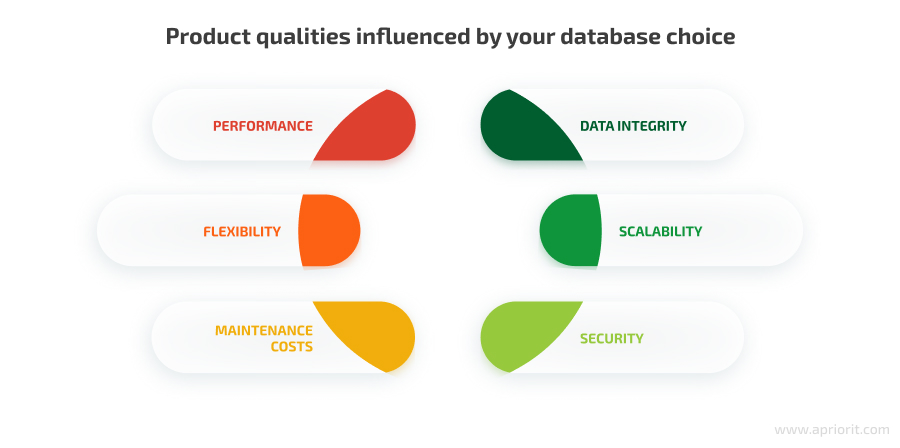
- Performance. Choosing the right database enhances response times, improves the user experience, and optimizes system efficiency for seamless operation.
- Scalability. A suitable database ensures your product can effortlessly handle a changing number of users and data traffic and ensure smooth database scaling, both up and down.
- Data integrity. The correct database guarantees consistent, error-free, and accurate data storage, making for reliable business operations.
- Maintenance costs. A proper database minimizes maintenance efforts, making addressing any fixes time- and resource-efficient.
- Flexibility. A well-suited database makes it easy to implement new features and quickly adapt to evolving business needs.
- Security. A deep understanding of how your database works can help you properly protect your data, avoid data inconsistencies, and enforce security measures like access control, compliance, and encryption.
As you can see, there’s much at stake when you choose a database. To make the correct choice, you must first learn the peculiarities of relational and non-relational databases and see which fits your product’s specific criteria. Let’s start with exploring each type of database in detail and review the relational vs non-relational database pros and cons.
Need to build reliable infrastructure?
Our team of experts can create a secure back end that can meet any business needs!
Relational databases: pros, cons, and examples
A relational database uses the relational model to organize and store data. In this model, data is organized into tables with rows and columns, and relationships between tables are established using keys.
Relational databases are managed with a relational database management system (RDBMS). These systems adhere to Atomicity, Consistency, Isolation, and Durability (ACID) properties to guarantee the reliability of transactions and use Structured Query Language (SQL) to define, query, and manage data.
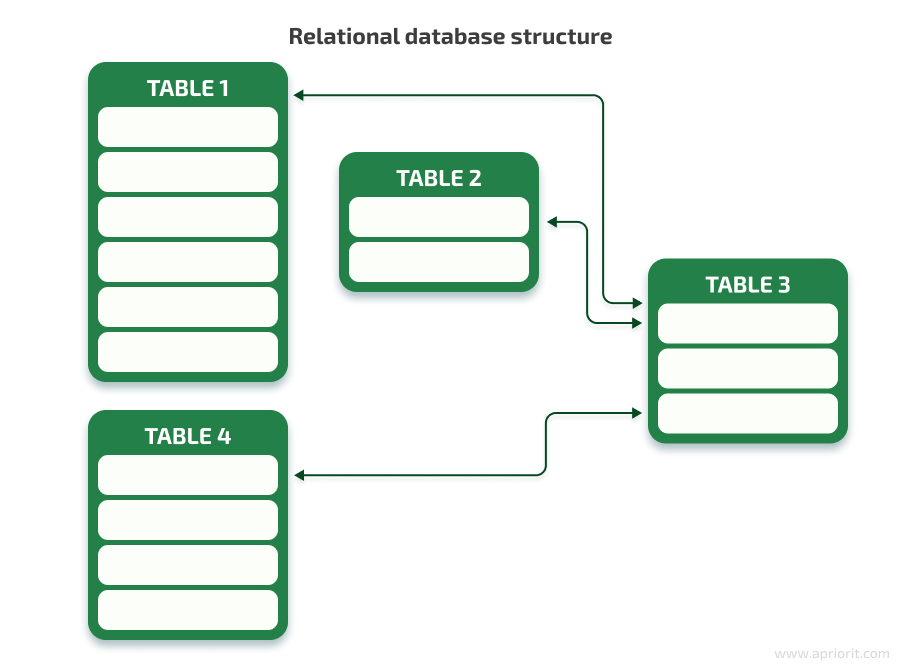
Let’s discuss the main pros and cons of relational databases.
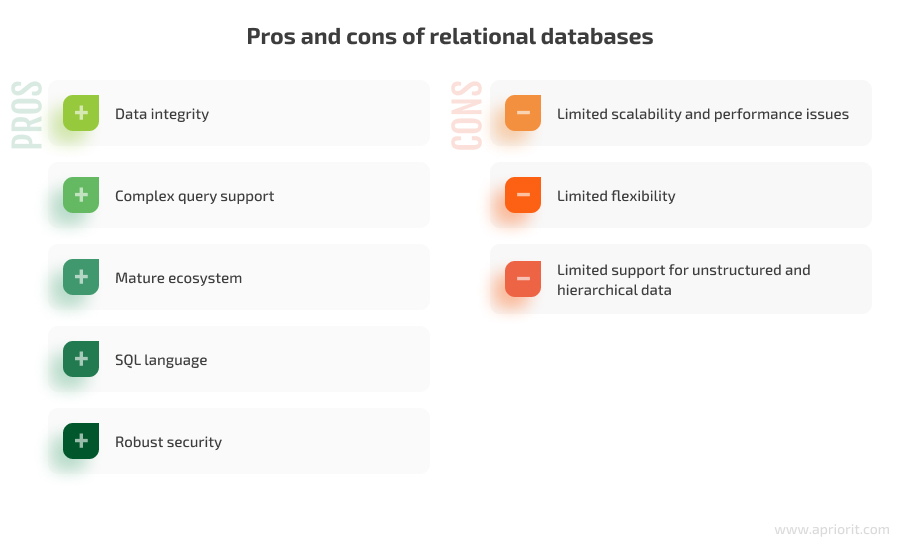
Advantages of relational databases include:
- Data integrity — Constraints of a relational database ensure accurate and consistent data, and features like normalization allow for reducing data redundancy and dependency.
- Complex query support — Unique identifiers called keys help to efficiently manage relationships between tables and enable the execution of queries that involve multiple tables. This makes relational databases suitable for complex data retrieval and analysis.
- Mature ecosystem — Relational databases have a full ecosystem of additional tools like MySQL Workbench, SQLite Manager, and PostgreSQL Management Studio. They allow developers to build database infrastructure faster using ready-made solutions.
- SQL language — This standardized and powerful language allows developers to define, query, and manipulate data efficiently.
- Robust security — Features like authentication, authorization, and encryption ensure reliable protection for your valuable business and user data.
Relational databases have their drawbacks too. They include:
- Limited scalability and performance issues — Scaling relational databases can be challenging when dealing with massive amounts of data. Large datasets and complex queries also harm performance. This can slow your product, cause errors, and decrease user satisfaction.
- Limited flexibility — Changes to the database schema can be complex and time-consuming, impacting the flexibility to adapt to evolving requirements.
- Limited support for unstructured and hierarchical data — Relational databases are less suitable for handling unstructured or semi-structured data. Representing hierarchical data structures, such as trees or graphs, can be less intuitive in relational databases.
The most popular relational database management systems include:
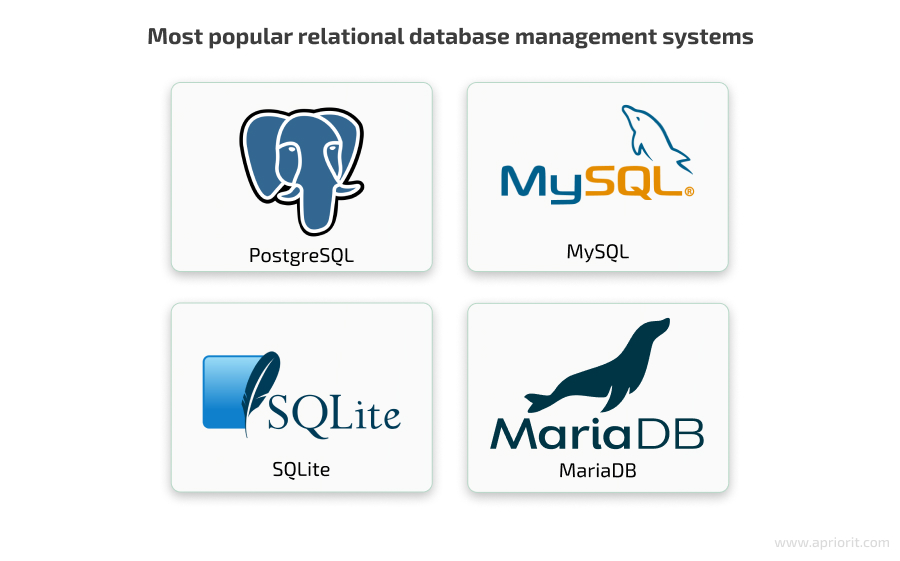
PostgreSQL is a powerful open-source relational database management system (RDBMS) that supports many data formats, allows for creating custom formats, and offers robust indexing and data manipulation features. Known for its robustness and reliability, this RDBMS is perfect for complex products that require high transactional integrity, such as enterprise applications, content management systems, data warehousing, and financial applications.
SQLite is a lightweight, self-contained RDBMS that stores all data in a single file. Its simplicity and minimal configuration make it ideal for small projects and mobile applications, offering an easy-to-use, serverless solution.
MySQL is one of the world’s most popular RDBMSs, widely used in web development and integral to the standard LAMP (Linux, Apache, MySQL, PHP) stack. It’s reliable and scalable and suits both large-scale enterprises and small apps and websites.
MariaDB is a fully compatible alternative to MySQL that offers additional features and database performance improvements. MariaDB is well-suited for data-intensive projects that require flexibility and MySQL compatibility.
Read also
Data Management Based on SQL Server: On-Premises vs Cloud Database
Compare on-premises and cloud SQL Server installations based on cost-efficiency, security, flexibility, and data control.

Now let’s look at non-relational databases and discuss their main features, pros and cons, and popular database management systems.
Non-relational databases: pros, cons, and examples
Non-relational databases, or NoSQL databases, offer an alternative approach to handling data compared to traditional relational databases. They can store structured, unstructured, and semi-structured data.
Non-relational databases can take various forms, such as document-oriented, key-value, column-family, and graph databases. NoSQL databases provide flexibility in data modeling, allowing for different structures and schemas based on your application’s specific needs.
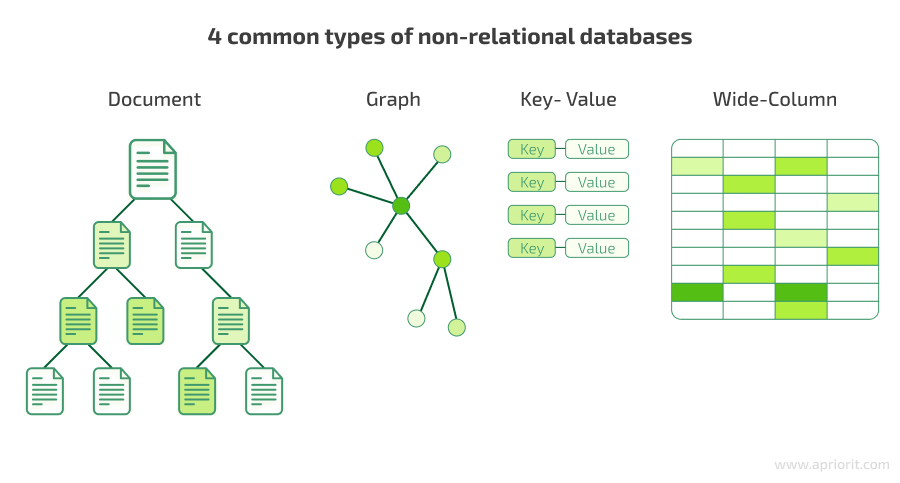
Let’s look at the main pros and cons of non-relational databases.
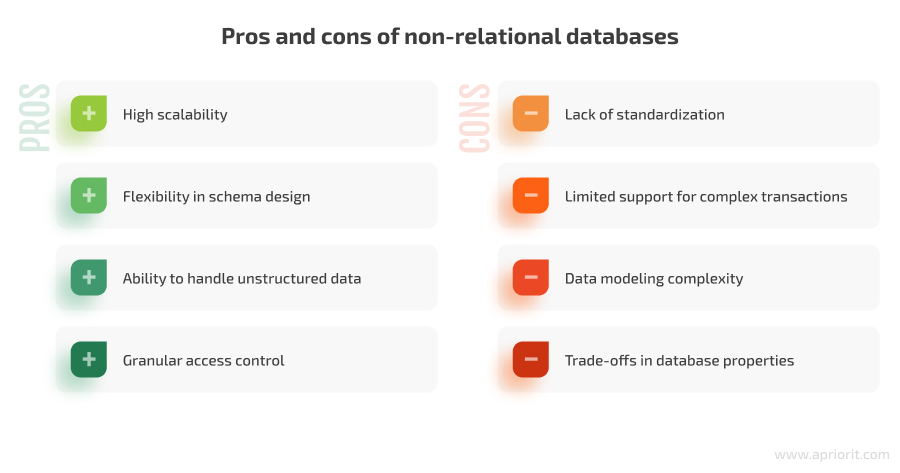
Advantages of non-relational databases include:
- High scalability — Many NoSQL databases are designed for horizontal scalability, allowing them to efficiently distribute data across multiple servers or nodes. This allows businesses to expand their infrastructure and seamlessly handle growing traffic, thus improving the user experience regardless of the customer base.
- Flexibility in schema design — NoSQL databases allow developers to adapt data models without the constraints of predefined schemas. This allows businesses to quickly respond to user feedback and market trends by rolling out new features and products.
- Ability to process unstructured data — NoSQL databases are able to process unstructured data in real time, which allows them to work with content management systems and IoT applications. The ability to experiment with different data structures allows businesses to quickly adapt to industry or user needs.
- Granular access control — In non-relational databases, access control can be enforced at the document and even field level. This means individual documents or records within a collection can have distinct access permissions, allowing for precise control over who can read, write, or modify specific pieces of data.
Despite the flexibility of non-relational databases, you may face certain challenges when working with them:
- Lack of standardization — Unlike relational databases that use SQL as a standardized query language, NoSQL databases lack a universal language. Each type of NoSQL database has its own query language or API, making it more challenging for developers to switch between databases.
- Limited support for complex transactions — NoSQL databases handle complex transactions less efficiently compared to traditional relational databases. This can be a challenge when applications (such as e-commerce apps) require multi-step transactions or ACID compliance. However, many NoSQL databases have significantly improved their ability to process complex transactions.
- Complex data modeling — While NoSQL databases provide flexibility in schema design, it can be challenging for developers to model data structures. They need to carefully plan out the data structure for each use case and make it manageable in the long run.
- Trade-offs in database properties — NoSQL databases often involve trade-offs between consistency, availability, and partition tolerance. Choosing the right balance for a specific application can be challenging, and emphasis on one aspect may come at the expense of others.
The most popular non-relational database management systems include:
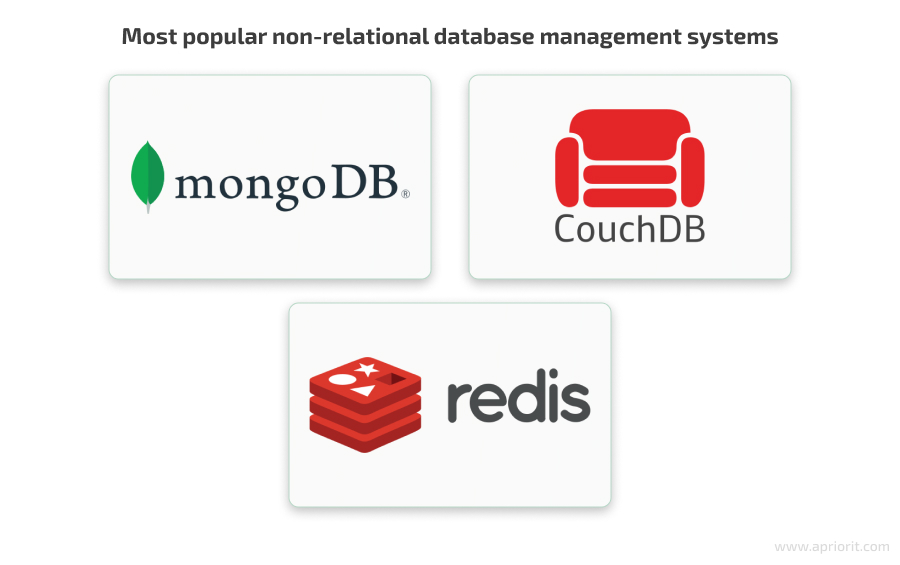
MongoDB is a flexible, document-oriented database storing data in BSON format. Its schema flexibility allows for hierarchical data, supporting scalability without the need for table joins. For example, you can store information about a user, their contacts, purchase history, and reviews in one structure without the need to join tables. This ensures quick access to data and simple scaling.
CouchDB is a document-oriented database with a data model similar to MongoDB. It focuses on storing and syncing data across nodes and devices, offering distributed data management. This makes CouchDB ideal for collaborative platforms and offline-capable applications.
Redis is an in-memory key-value database that prioritizes fast access by storing data in RAM. It’s commonly used for caching and supports complex data types like lists, hashes, and sets. Redis is perfect for scenarios demanding high performance and real-time data access, making it a go-to choice for caching, session storage, and applications requiring rapid data retrieval.
So, how can you make the right choice? Let’s look at how our team chooses between relational and non-relational databases in a few steps.
Related project
Building AWS-based Blockchain Infrastructure for International Banking
Learn how the Apriorit team designed, tested, and implemented AWS architecture using DynamoDB.

Choosing between relational vs. non-relational databases: Apriorit’s recommendations
Now that we explored the differences between relational and non-relational databases, let’s find out how to choose the perfect one for your product. To ensure your database type fits your product, you need to define your software’s unique business and technical needs. Here are our top recommendations on what to consider when choosing between relational and non-relational databases for your product.
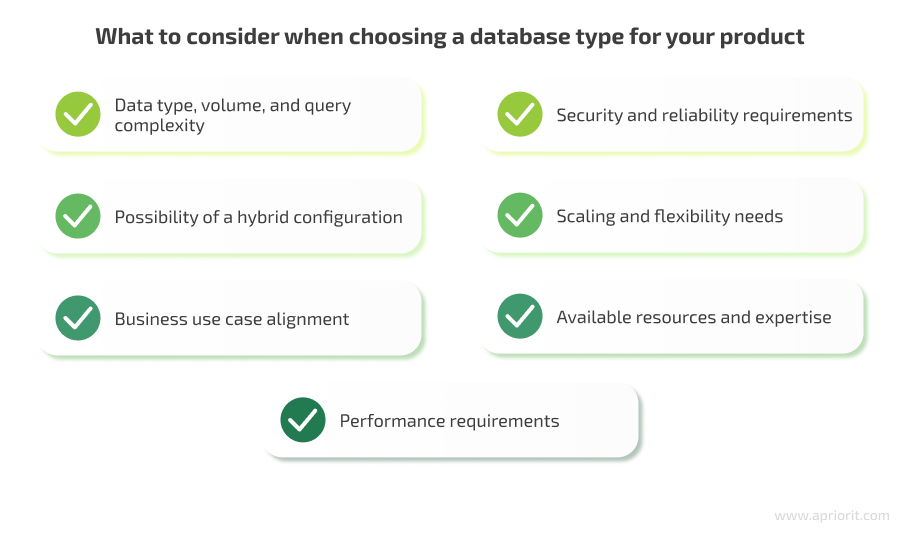
1. Consider your data type, volume, and query complexity
It’s important to understand what types and amounts of data your solution will handle. This will help you understand when to use a non-relational database, and when to use a relational database.
For instance, relational databases excel at handling structured, organized data with clear relationships and complex transactions. Here are the types of data that relational databases work best with:
- Structured text data like customer information, employee records, and financial transactions
- Numerical data like sales figures, inventory levels, and statistics
- Categorical data like product categories, employee roles, and customer segments
Non-relational databases, on the contrary, prioritize speed and a flexible data structure. They’re perfect for unstructured or frequently restructured data arrays. Here are some examples of data types that are suitable for non-relational databases:
- Unstructured text data like social media comments, blog posts, and user-generated content
- Media files like images, audio recordings, and video files
- Time-series data like sensor data, IoT logs, and event timestamps
- JSON and XML documents like configurations and nested data structures
- Key–value pairs like caching data and configuration settings
The volume of data also plays a significant role: non-relational databases typically can work with larger amounts of data compared to relational databases, ranging from several terabytes to petabytes. However, their efficiency depends on the data type, so you need to plan what types of data your product will deal with.
Another nuance to keep in mind is the way your product retrieves data. Relational databases work best with complex requests that involve multiple tables, joins, and aggregations: for example, financial transactions, inventory updates, analytical requests, and reporting.
NoSQL databases work best with simple and quick data access patterns, making them suitable for real-time big data processing, content management systems, and scenarios where flexibility in data models is crucial, such as IoT applications and projects with evolving data structures.
2. Align your database with your business use cases
Your choice of database should depend on your unique project requirements and use cases. Let’s look at some examples of products that will most benefit from relational or non-relational databases.
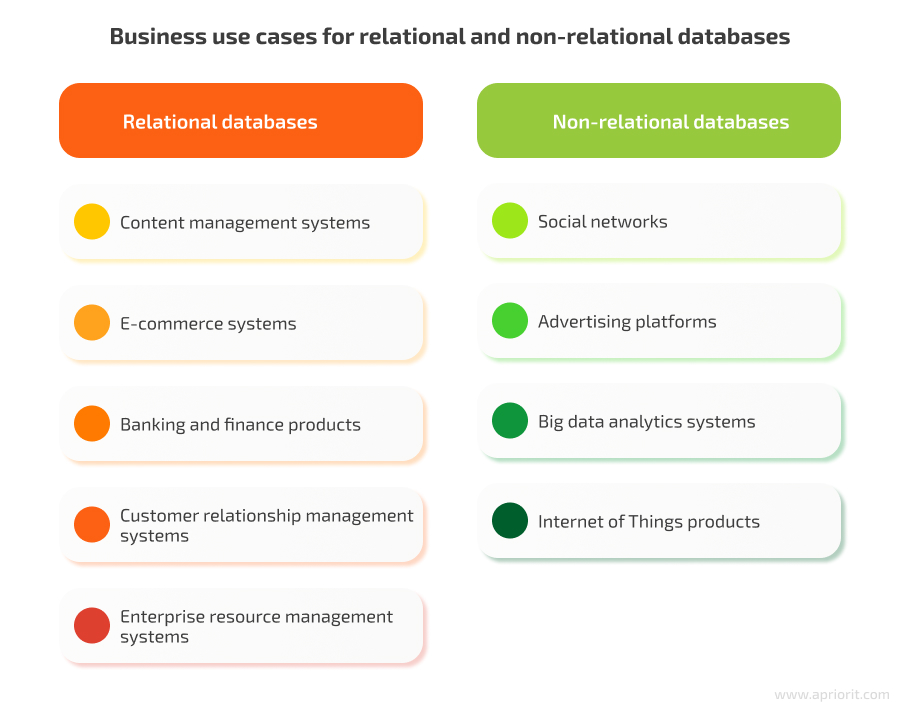
Let’s start with software product categories that work best with relational databases:
Content management systems (CMSs). Relational databases are a great choice for CMS platforms like WordPress and Drupal. These systems typically handle large amounts of content-related structured data like articles or pages, requiring complex queries for content creation, updates, and retrieval.
E-commerce systems. E-commerce platforms like Amazon and eBay utilize relational databases for transaction processing, inventory management, and customer service.
Banking and financial products. Banks and financial institutions leverage relational databases for processing intricate transactions, including fund transfers and credit and debit operations.
Customer relationship management (CRM) systems. CRM systems like Salesforce rely on relational databases to manage customer information, deals, leads, and marketing campaigns.
Enterprise resource planning (ERP) systems. ERP systems such as SAP and Oracle use relational databases to manage enterprise resources, covering finance, production, procurement, customer service, and human resources.
Now let’s look at examples of products where non-relational databases are the most effective.
Social networks. NoSQL databases are used in social networks to handle large volumes of unstructured data, such as messages, posts, likes, and comments. These applications require fast and efficient data access, which NoSQL databases provide.
Advertising platforms. Companies in the advertising technology sector often use NoSQL databases to process large volumes of real-time data.
Big data analytics. Products dealing with big data, such as AWS, utilize NoSQL databases for processing and analyzing vast amounts of data.
Internet of Things (IoT) products. IoT applications, managing extensive data from numerous devices, frequently leverage NoSQL databases for rapid data writing and retrieval.
As you can see, relational databases are about structured data and complex queries, which is perfect for content management systems or financial transactions. Non-relational databases are ideal for applications that deal with real-time, unstructured data.
Related project
Developing and Supporting a CRM System for a Medical Transportation Company
Learn how the Apriorit team improved the security of the company’s existing solution, rewrote legacy code, and created new modules for the CRM.

3. Consider your product’s scaling and flexibility needs
Scaling and flexibility are essential factors that can influence your product in the long run. Many businesses face scaling challenges if they haven’t predicted their future growth at the initial stages of product development. To avoid such issues, you need to evaluate your future scaling needs and choose a database accordingly.
While you can scale both relational and non-relational databases, it might be more challenging and time-consuming to do so for relational databases. To scale a relational database, developers usually replicate it and place copies across several servers to distribute the load.
This procedure requires manual configuration and meticulous planning from developers but also provides precise control over database distribution and configuration. You can also use third-party tools to simplify and automate this process. These tools often provide features like automated failover, load balancing, and streamlined configuration management.
Meanwhile, non-relational databases like MongoDB support native data distribution and can add nodes to clusters automatically. This makes scaling effortless, as it requires less manual configuration, making it well-suited for dynamic and rapidly changing workloads.
With relational databases, you need to decide on your data storage structure from the start. The data storage structure or scheme consists of a set of tables and fields, their predetermined sizes and types, as well as keys that bind them all together. In a table, all rows and records must follow the same structure — once a table schema is defined, it’s hard or even impossible to add a new column in the future.
Non-relational databases use documents rather than tables. Each document within a collection has different fields, types, and structures. This allows for making dynamic changes without affecting existing data. For example, one document in a user collection may have an additional field like address, while another may not.
We can see this in a visual example of what typical document structures in MongoDB (non-relational) and MySQL (relational) look like.
MySQL (relational):
CREATE TABLE users (
id INT PRIMARY KEY,
name VARCHAR(255),
description VARCHAR(255),
email VARCHAR(255),
password VARCHAR(100)
);MongoDB (non-relational)
{
"_id": ObjectID,
"name": String,
"description": String,
"email": String,
"password": String
}As you can see, in the MySQL table, each field has a predefined type and length — VARCHAR(255), where VARCHAR is a variable-length character string and 255 is the maximum length of 255 characters. If you need to store longer names or descriptions in the future, you’ll have to change the table structure, which is challenging, especially if data has already been recorded.
In contrast, MongoDB fields are strings without predefined lengths. This flexibility allows for variations in data length without requiring structural changes. If one document has a longer name, MongoDB can accommodate it without any predefined constraints.
The data structure also influences the flexibility of your solution. Relational databases enforce data normalization — a practice that helps to avoid data duplication and makes database maintenance easier. In non-relational databases, normalization isn’t as strict, so these databases are more flexible in their data structure. Sometimes, non-relational databases use data denormalization to increase scalability and performance.
For example, in document-oriented databases like MongoDB, data is typically denormalized and stored as nested data structures, allowing you to quickly retrieve all related data in a single query. However, this can lead to data duplication and complicate data updates.
How We Scaled API Performance in a High-Load System and Avoided CPU Overload
Read also
Explore how Apriort scaled a highly loaded API that processes resource-intensive requests.

4. Define your performance requirements
The performance of relational and non-relational databases depends on factors like data type, query complexity, and data volumes. However, both of these database types have their strengths and weaknesses. To demonstrate this, we did a performance test for MongoDB and MySQL.
You can see the configuration and all test conditions and details below:
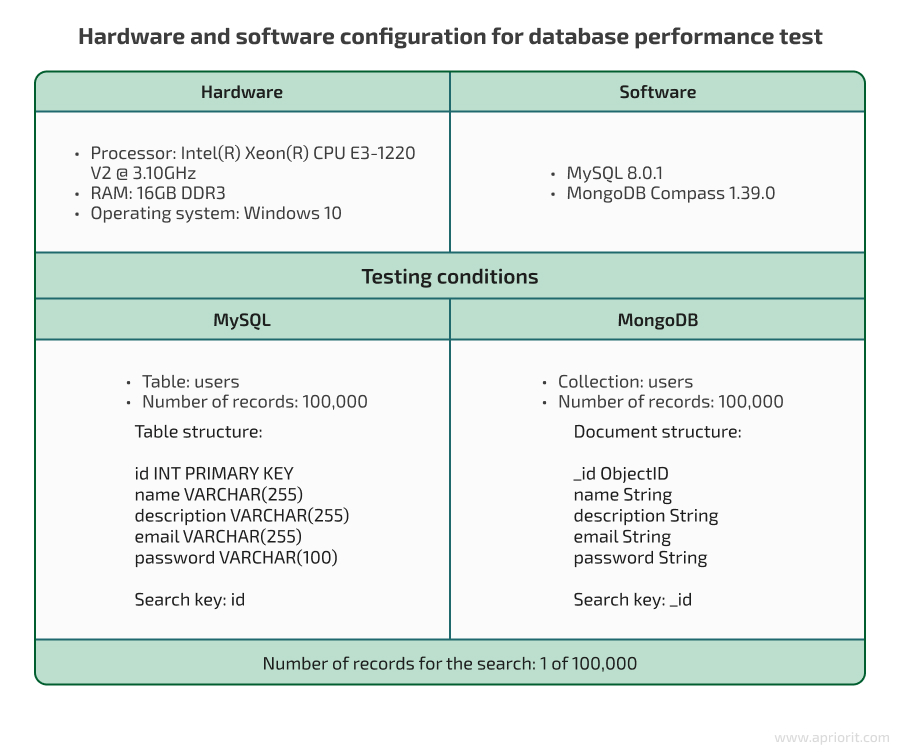
Now let’s run the test and look at the results:
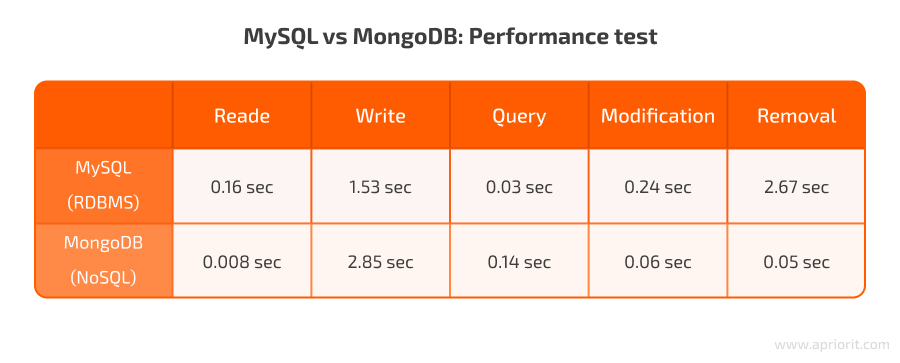
MongoDB is faster than MySQL in read operations but slower in write operations. The reason for this is that MongoDB stores data in a format similar to JSON, which allows for faster data reading. However, writing is slower because the data structure isn’t strict.
NoSQL databases are usually faster and can quickly process large amounts of data. This makes them ideal for real-time applications. On the other hand, if data is structured, SQL databases are best at retrieving it, even with complex queries.
5. Assess your security and reliability requirements
The reliability and data security of a database directly translates into your business success. Any breach can compromise your invaluable user or application data, leading to financial losses, reputational damage, and operational disruptions.
Moreover, many businesses have specific data security requirements, so you need to make sure your database complies with them. Let’s examine key aspects of cybersecurity and how both database types relate to them.
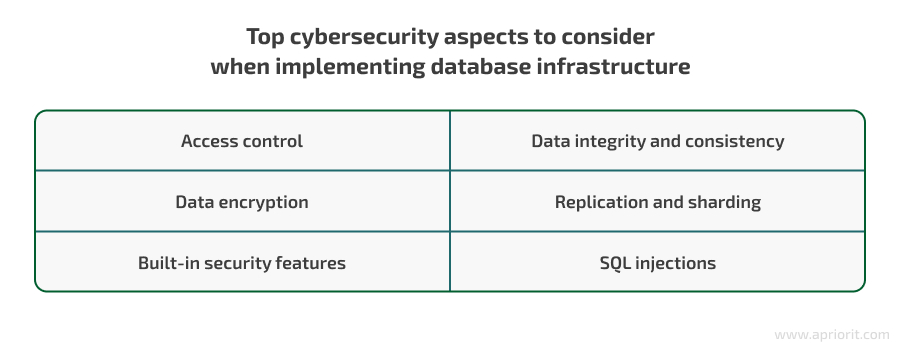
1. Access control. This critical aspect determines who can access, modify, and interact with data. In relational databases, access control is often performed at the database, table, or view level using SQL commands like GRANT and REVOKE. This centralized approach allows businesses to manage permissions for entire databases, tables, or views. This can be advantageous for scenarios where a consistent access policy is suitable for all data entities.
In NoSQL databases, access control varies depending on the database type. For instance, document-oriented NoSQL databases, such as MongoDB, can provide users with access control at the level of individual documents or even fields within documents. This granular approach allows businesses to meet nuanced access requirements and grant access to specific documents and fields within various data structures.
2. Data integrity and consistency. Both relational and non-relational databases provide secure ways to store and retrieve data. Relational databases adhere to ACID properties to ensure the consistency and integrity of data and minimize the risk of data corruption or loss. This approach is well-suited for services that require extreme data accuracy and transactional integrity, such as financial systems or transactional applications.
Most NoSQL databases follow the BASE model (Basically Available, Soft State, Eventual Consistency) that guarantees high availability and resilience, especially in distributed and dynamic systems. This approach suits applications where high availability and scalability are crucial, such as in web applications or systems with large-scale distributed data.
3. Data encryption. Both relational and non-relational databases support data encryption at rest and in transit; however, their implementation may differ. For example, relational databases typically use a single key to encrypt all data in a table, and if the key is lost, access to the data becomes impossible. In contrast, non-relational databases can use different encryption keys for different parts of data. However, this encryption approach in NoSQL may impact performance.
Both approaches are secure, but they have unique tradeoffs: relational databases require strict key management, and non-relational databases may trade high performance for encryption flexibility.
4. Replication and sharding. Many NoSQL databases are designed for working with distributed systems, offering features like automatic sharding and replication. These capabilities enhance data protection by ensuring data availability and durability even in the event of a failure in some parts of the system. These features are typically not built into relational databases and may require manual configuration or use of additional tools.
5. Built-in security features. Some NoSQL databases may not provide built-in features for specific security policies like views and stored procedures commonly found in relational databases. On the other hand, NoSQL databases often offer unique security mechanisms suitable for their specific data models.
6. Protection from SQL injection. Relational databases are susceptible to SQL injection attacks that may lead to unauthorized data access or loss. In contrast, many NoSQL databases do not use SQL, avoiding SQL injection. However, without adequate protection, they may be vulnerable to other types of injection, such as NoSQL injection.
To protect any database from SQL or NoSQL injection and other cybersecurity threats, you need to apply strong security measures like access control, input validation, and firewall integration and conduct regular security audits.
Read also
How to Ensure SaaS Data Security with Curated Database Design
Learn about the role of database design in SaaS security and explore proven ways to protect data in storage and during software maintenance.

6. Evaluate available resources and expertise
Choosing the right database involves not just understanding your project but also realistically assessing your team’s expertise and available tools. If your team lacks experience with a particular type of database, we recommend involving external experts.
Apriorit’s team of specialists can support you at any stage of development, from consulting on your unique database architecture to implementing, scaling, and supporting it. Our backend specialists have expertise working with both relational and non-relational databases, so whether your product needs structure or flexibility, we make sure your software reflects your specific business needs.
7. Consider a hybrid configuration
If you feel like your product requires both the flexibility of a NoSQL database and the structure of an SQL database, consider a hybrid approach. It combines the properties of relational and non-relational databases within a single product and has gained popularity as products become more complex and versatile.
With a hybrid strategy, you can leverage the strengths of each database type and tailor your database architecture to your specific needs. Let’s briefly look at the pros and cons of a hybrid approach.
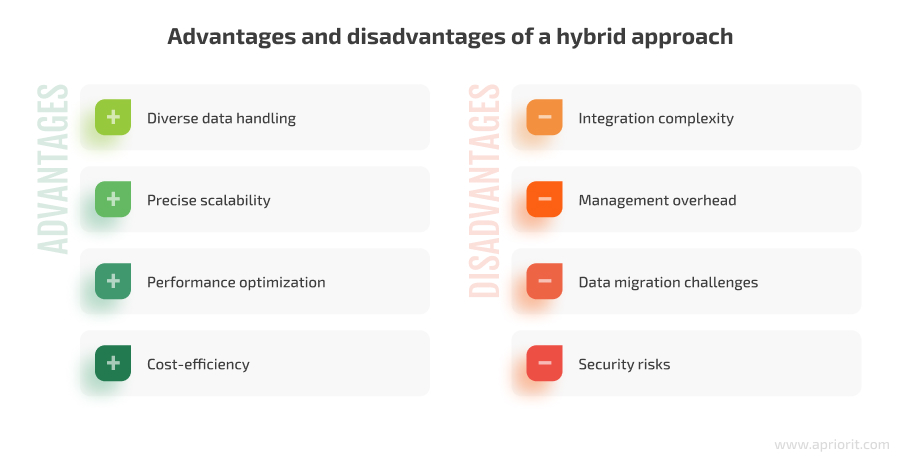
Let’s start with the advantages:
- Diverse data handling — Combine both structured and unstructured data types within your solution and have dedicated databases to deal with both of them.
- Precise scalability — Scale your non-relational databases horizontally and allow them to handle many simple requests while dedicating your relational databases to complex queries.
- Performance optimization — Trust relational databases with critical operations, and leave high-velocity tasks to faster non-relational databases.
- Cost-efficiency — You can optimize costs by allocating both databases to different tasks and data types. For example, non-relational databases are often more cost-efficient for storing large amounts of unstructured data.
Like any complex architecture, the combination of different types of databases comes at a price. Here are the downsides of a hybrid approach in database architecture:
- Integration complexity — It may be hard to combine several databases into one system, as you need to take care of data consistency and efficient communication despite different data formats.
- Management overhead — It can be time- and resource-consuming to manage two types of databases. Your team should have expertise in relational and non-relational databases and have enough resources for database management.
- Data migration challenges — Transferring data between two database types can be complex, so you need to establish robust strategies to migrate, synchronize, and protect your data from inconsistencies and even loss during the transition.
- Security risks — Hybrid architectures present additional potential vulnerabilities and require strict security measures to protect data across both types of databases.
While the hybrid approach introduces complexities, you can gain an architecture that will perfectly align with your product goals. At Apriorit, we recommend a hybrid data management architecture for complex products that deal with multiple data types.
Conclusion
Choosing a database type for your product is a strategic decision that defines software performance, scalability, and efficiency in the long run. Relational databases are best suited for structured data and complex queries, while non-relational databases give you flexibility, speed, and scalability.
Many businesses today combine both database types to achieve maximum flexibility and reliability. However, the hybrid approach requires expertise, planning, and a robust security strategy.
At Apriorit, you can leverage our backend development expertise to build the perfect architecture for your unique business needs. Our experts are well-versed in both relational and non-relational databases and can choose the right data management strategy for your use case, with an emphasis on security and reliability.
Need to build a robust back end for your product?
Leverage Apriorit engineers’ expertise to get scalable infrastructure that reflects your business needs!


